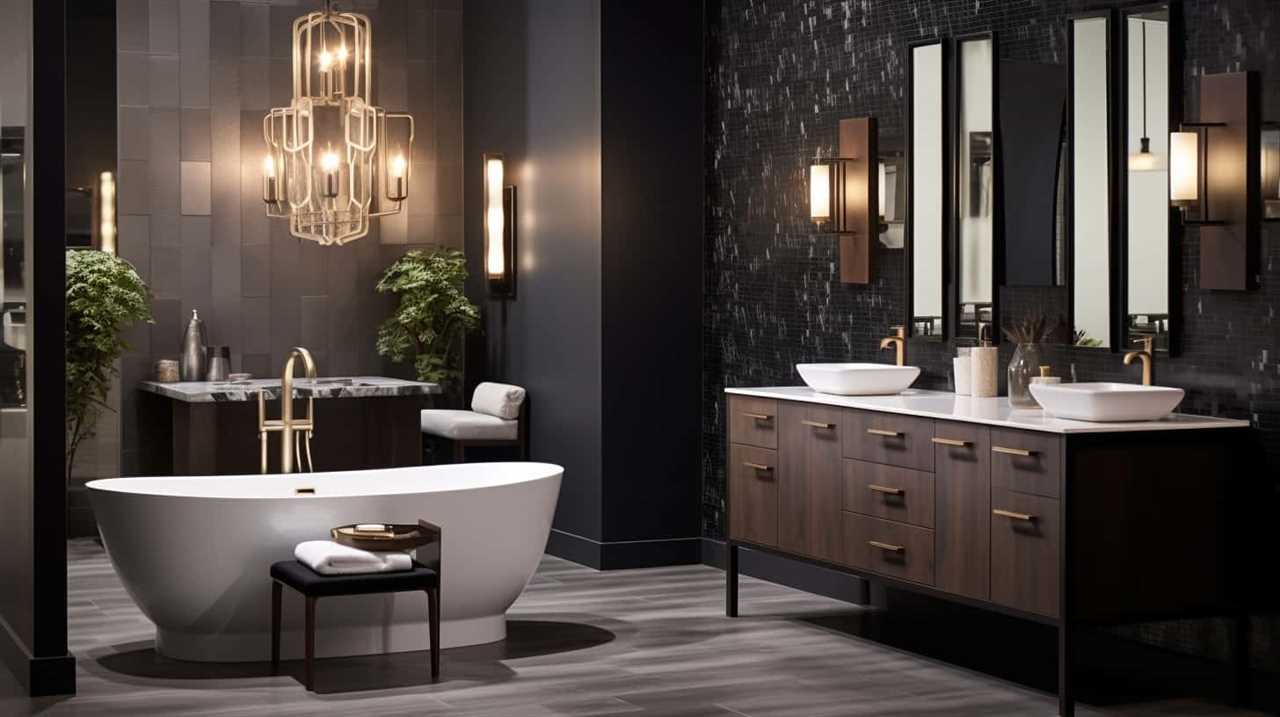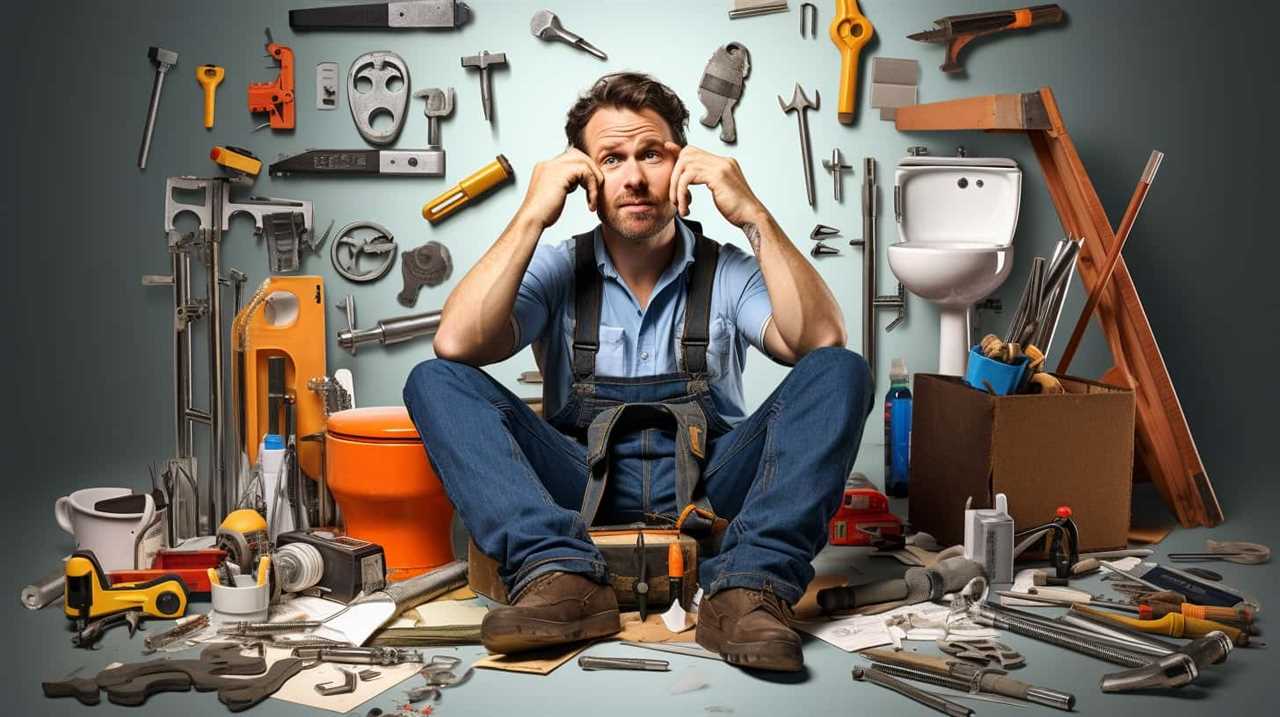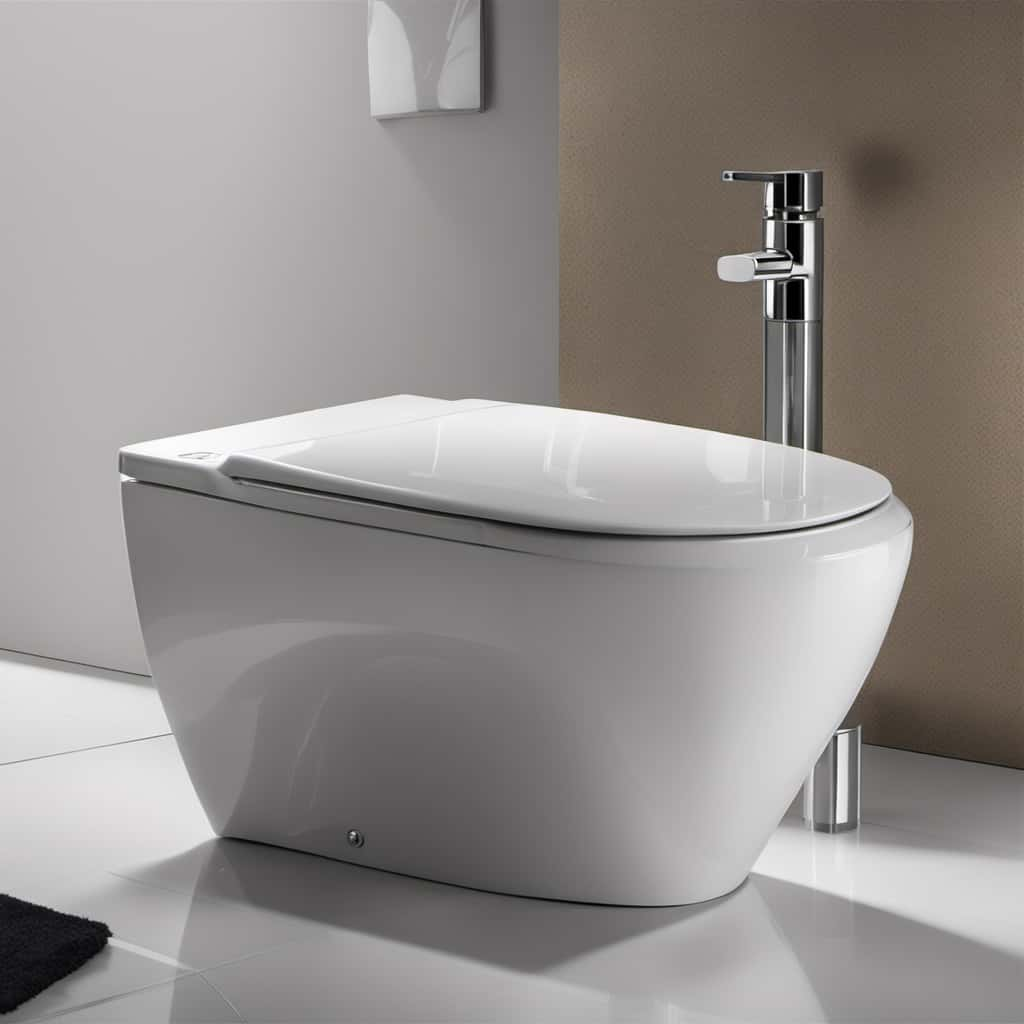Bathroom Enhancements
Shower Valve

Are you fed up with a shower valve that keeps causing issues? Well, we have some great news for you.
In this article, we will be discussing different types of shower valves, the benefits of upgrading, factors to consider when choosing one, and even how to remove and replace a shower valve yourself.
We’ll also cover common issues you may encounter and provide solutions to fix them.
Get ready to master your shower valve game!

Key Takeaways
- Different types of shower valves include traditional two-handle valves, single-handle valves, and thermostatic valves.
- Upgrading your shower valve can provide benefits such as consistent water temperature, better water pressure control, energy efficiency, longevity, durability, and an enhanced showering experience.
- When choosing a shower valve, factors to consider include easy cleaning and maintenance, accessible parts for replacement, the importance of proper installation, and the option of hiring a professional plumber to prevent water damage and costly repairs.
- Steps to remove and replace a shower valve include turning off the water supply, removing the trim and handle, disconnecting the water supply lines, removing the old valve, installing the new valve, reconnecting the water supply lines, testing for leaks, and reinstalling the trim and handle.
Types of Shower Valves
We will now discuss the different types of shower valves.
When it comes to shower valve installation, it’s important to understand the various options available.
The first type is the traditional two-handle valve. This classic design allows for separate control of hot and cold water, providing precise temperature adjustments.
Another option is the single-handle valve, which combines both temperature and volume control into one convenient lever. This type is easier to use and allows for quick adjustments.

For those seeking a more advanced option, thermostatic valves are an excellent choice. These valves maintain a constant water temperature, even when there are fluctuations in water pressure.
Regardless of the type of valve chosen, regular shower valve maintenance is crucial to ensure optimal performance and longevity.
Benefits of Upgrading Your Shower Valve
Why should you consider upgrading your shower valve? There are several advantages and reasons to make this investment. Upgrading your shower valve can significantly improve your showering experience and enhance the overall functionality of your bathroom. Let’s take a look at some of the benefits:
| Advantages | Reasons |
|---|---|
| Consistent water temperature | Prevent scalding accidents |
| Better water pressure control | Enjoy a more comfortable shower |
| Energy efficiency | Reduce water and energy consumption |
| Longevity and durability | Avoid frequent repairs and replacements |
Factors to Consider When Choosing a Shower Valve
Now that we’ve explored the benefits of upgrading your shower valve, it’s crucial to consider factors such as shower valve maintenance and the importance of proper shower valve installation when choosing a shower valve.

Maintaining your shower valve is essential to ensure its longevity and optimal performance. Look for a valve that’s easy to clean and maintain, with accessible parts that can be easily replaced if needed.
Additionally, proper installation is vital to prevent leaks and ensure the valve operates effectively. Consider hiring a professional plumber to install your shower valve correctly, as improper installation can lead to water damage and costly repairs down the line.
Steps to Remove and Replace a Shower Valve
After considering factors such as shower valve maintenance and proper installation, let’s now delve into the steps to remove and replace a shower valve.
Here are the steps to follow for a successful shower valve installation:

- Turn off the water supply: Before starting any work, locate the main water shut-off valve and turn it off to prevent any water flow.
- Remove the trim and handle: Unscrew the trim plate and remove the handle to expose the valve.
- Disconnect the water supply lines: Use a wrench to disconnect the hot and cold water supply lines from the valve.
- Remove the valve: Depending on the type of valve, you may need to use a valve removal tool or a wrench to unscrew and remove it.
- Install the new valve: Follow the manufacturer’s instructions to properly install the new valve.
- Reconnect the water supply lines: Use a wrench to reconnect the hot and cold water supply lines to the new valve.
- Test for leaks: Turn on the water supply and check for any leaks. Make sure the valve is functioning properly.
- Reinstall the trim and handle: Screw the trim plate back in place and reinstall the handle.
Common Issues With Shower Valves and How to Fix Them
We have encountered common issues with shower valves and successfully fixed them using simple solutions. Proper shower valve maintenance is essential to ensure optimal performance and prevent potential problems.
One common issue is a leaky shower valve, which can be caused by a worn-out cartridge or a faulty seal. To fix this, you can replace the cartridge or the seal, depending on the specific problem.
Another issue is reduced water pressure, which may be caused by a clogged valve or a problem with the water supply. Troubleshooting shower valve issues involves checking for any blockages and ensuring that the water supply is adequate.
Frequently Asked Questions
Can I Install a Shower Valve by Myself, or Do I Need to Hire a Professional Plumber?
We can install a shower valve ourselves, but hiring a professional plumber is recommended. Installing a shower valve requires technical expertise and precise knowledge to ensure proper installation and avoid potential issues.

What Is the Average Lifespan of a Shower Valve?
The average lifespan of a shower valve varies depending on factors such as usage and maintenance. Proper installation process is crucial for ensuring its longevity. It is recommended to consult a professional plumber for best results.
Are There Any Specific Maintenance Tasks I Should Perform to Keep My Shower Valve in Good Working Condition?
To keep our shower valve in good working condition, we should perform regular maintenance tasks. This includes checking for leaks, cleaning the valve and its components, and ensuring proper water pressure. Neglecting these tasks can lead to common shower valve problems.
Can I Use Any Type of Shower Head With Any Shower Valve, or Do I Need to Consider Compatibility?
Any type of shower head may not be compatible with any shower valve. It is important to consider compatibility to ensure proper water flow and avoid potential leaks or damage. Different shower valve types offer various benefits.
Are There Any Safety Features or Certifications I Should Look for When Choosing a Shower Valve?
When choosing a shower valve, it’s important to consider safety features and certifications. Look for valves that meet industry standards and have certifications like ADA compliance or NSF certification. Factors like performance and durability also affect the valve’s effectiveness.

Conclusion
In conclusion, upgrading your shower valve can greatly improve your bathing experience. It’s like replacing an old, rusty faucet with a sleek, modern one – the difference is night and day.
Not only will you enjoy better water pressure and temperature control, but you’ll also avoid common issues like leaks and clogs.
So don’t hesitate to invest in a high-quality shower valve – it’s a small change that can make a big difference in your daily routine.
With an impeccable eye for detail and a passion for bathroom-related, Ava leads our editorial team gracefully and precisely.
Under her guidance, Best Modern Toilet has flourished as the go-to resource for modern bathroom enthusiasts. In her free time, you might find Ava exploring antique shops and looking for vintage bathroom fixtures to add to her collection.
Bathroom Enhancements
Are You Allowed to Flush Toilet Paper in Bali

Is it true that we have to throw away toilet paper differently in Bali? This is unbelievable!
Well, get ready for a wild ride as we uncover the truth about flushing toilet paper on this beautiful island. From local plumbing practices to the environmental impact, we’ll explore it all.
Plus, we’ll dish out some handy tips and alternatives to keep you in the good graces of Bali’s plumbing system.
Hold on tight, folks, this is going to be an eye-opening journey!

Key Takeaways
- Flushing toilet paper is generally not recommended in Bali due to hygiene concerns and cultural norms.
- Plumbing infrastructure in many areas of Bali can’t handle the disposal of toilet paper, leading to potential clogs and blockages.
- Using waste bins to dispose of toilet paper maintains good hygiene and prevents plumbing mishaps.
- Adhering to the no-flush policy ensures a smooth experience in Bali.
Local Plumbing Practices
In our experience, we’ve found that in Bali, toilet paper is typically disposed of in a waste bin next to the toilet, rather than being flushed down the toilet. This unique practice stems from common plumbing issues and traditional waste management practices in the area.
Bali, known for its stunning landscapes and vibrant culture, faces challenges when it comes to plumbing infrastructure. The narrow pipes and limited water pressure make it difficult for the toilet paper to dissolve and flow smoothly through the system. As a result, locals have adopted the practice of disposing of toilet paper in a waste bin to prevent clogs and backups.
While this may seem unusual to visitors, it’s an important aspect of respecting and preserving the local plumbing system. Understanding and adhering to these practices will ensure a hassle-free and enjoyable experience during your stay in Bali.
The Truth About Flushing Toilet Paper
Continuing from our previous discussion on local plumbing practices in Bali, it’s important to address the truth about flushing toilet paper in this unique setting.

In Bali, it’s generally not recommended to flush toilet paper due to hygiene concerns and cultural norms. The plumbing infrastructure in many areas of Bali isn’t built to handle the disposal of toilet paper, leading to potential clogs and blockages.
To maintain good hygiene and prevent any plumbing mishaps, it’s advisable to use the provided waste bins to dispose of used toilet paper. While this practice may seem unfamiliar to some, it’s essential to respect the local customs and infrastructure.
Environmental Impact of Flushing Toilet Paper
To further explore the consequences of flushing toilet paper in Bali, let’s delve into the environmental impact of this practice. When we flush toilet paper, we often overlook the potential harm it can cause to our environment. Improper waste management and water pollution are two significant issues that arise from flushing toilet paper.
| Waste Management | Water Pollution |
|---|---|
| Inadequate waste management systems can lead to the accumulation of toilet paper in landfills, contributing to environmental pollution. | Flushing toilet paper can introduce harmful chemicals and microplastics into our water sources, posing a threat to aquatic life and ecosystems. It can also contaminate our drinking water, affecting human health. |
We must consider the long-term consequences of our actions and explore alternatives to mitigate the environmental impact. By adopting sustainable waste management practices and using eco-friendly alternatives such as bidets or recycled toilet paper, we can minimize the harm caused by flushing toilet paper. Let’s prioritize the health of our planet and make conscious choices to protect our environment.

Alternatives to Flushing Toilet Paper
As we consider the environmental impact of flushing toilet paper in Bali, let’s explore alternative options that can help minimize harm and promote sustainability.
One sustainable toilet paper option is to use bamboo toilet paper. Bamboo is a fast-growing plant that requires less water and chemicals compared to traditional wood pulp used in regular toilet paper.
Another alternative is to use bidets. Bidets are a great way to reduce the use of toilet paper altogether. They use water to clean, eliminating the need for excessive paper usage. Bidets are becoming increasingly popular and can easily be installed in existing bathrooms.
Not only are bidets better for the environment, but they also provide a more hygienic and refreshing cleaning experience.

Making these small changes can have a big impact on reducing waste and promoting a greener Bali.
Tips for Proper Disposal of Toilet Paper in Bali
An important aspect of ensuring proper sanitation and waste management in Bali includes the appropriate disposal of toilet paper. Cultural norms surrounding toilet paper in Bali may differ from what most tourists are accustomed to. While some establishments may allow you to flush toilet paper, it is generally advised to avoid doing so to prevent clogging the already fragile sewage systems. Instead, it is recommended to dispose of used toilet paper in the designated waste bins provided in bathrooms. This practice aligns with hygiene practices and public health concerns in Bali, as it helps to maintain the cleanliness of the facilities and prevent the spread of germs. By adhering to these disposal tips, we can contribute to the overall sanitation and well-being of the local community.
| Pros | Cons | Tips |
|---|---|---|
| Prevents clogged sewage systems | Requires additional waste bins | Use small amounts of toilet paper |
| Maintains cleanliness of facilities | Requires regular emptying of waste bins | Wrap used toilet paper properly before disposal |
| Reduces the spread of germs | May not be universally practiced | Follow local guidelines and customs |
Frequently Asked Questions
Can I Flush Toilet Paper in Bali?
Yes, we can flush toilet paper in Bali. It is common to use bidets here. However, it is not recommended to flush wet wipes as they can clog the plumbing system.
What Are the Local Plumbing Practices When It Comes to Toilet Paper Disposal in Bali?
Local customs regarding toilet paper disposal in Bali prioritize proper waste management. It is important to be mindful of the plumbing practices, as not all systems can handle flushing toilet paper.

What Is the Truth About Flushing Toilet Paper in Bali?
In Bali, we’ve discovered some interesting alternatives to flushing toilet paper. It seems that cultural beliefs and plumbing systems have led to different practices. Let’s dive into the truth about toilet paper disposal in Bali!
What Is the Environmental Impact of Flushing Toilet Paper in Bali?
Flushing toilet paper in Bali has a negative environmental impact. It hinders environmental sustainability and puts a strain on waste management systems. We should consider alternative solutions to minimize our ecological footprint.
Are There Any Alternatives to Flushing Toilet Paper in Bali?
There are several eco-friendly toilet paper alternatives available in Bali. We can consider using bidets, reusable cloth wipes, or even switch to bamboo toilet paper. These options reduce waste and have a lower environmental impact.
Conclusion
In conclusion, while the local plumbing practices in Bali may discourage flushing toilet paper, the truth is that it’s generally safe and acceptable to do so.

However, considering the environmental impact, it’s worth exploring alternatives like using bidets or installing composting toilets.
Ultimately, it’s important to be mindful of proper disposal methods to maintain hygiene and minimize pollution.
So let’s make informed choices and keep Bali clean and beautiful for generations to come.
With an impeccable eye for detail and a passion for bathroom-related, Ava leads our editorial team gracefully and precisely.
Under her guidance, Best Modern Toilet has flourished as the go-to resource for modern bathroom enthusiasts. In her free time, you might find Ava exploring antique shops and looking for vintage bathroom fixtures to add to her collection.
Bathroom Enhancements
Can You Just Replace the Flapper in a Toilet

Welcome, ladies and gentlemen, to our journey into mastering toilet repairs. Similar to how a skilled surgeon replaces a vital organ, we ponder the question, ‘Is it possible to simply replace the flapper in a toilet?’
In this concise guide, we will equip you with the knowledge and tools necessary to conquer this task. Prepare to embark on a journey through the inner workings of your porcelain throne, where we will unveil the signs, steps, and troubleshooting tips for replacing the elusive flapper.
Let’s dive in, shall we?
Key Takeaways
- The flapper regulates the flow of water from the tank into the bowl, and choosing the right flapper is essential for proper functioning.
- Signs that indicate a faulty flapper include water leakage into the toilet bowl, a hissing sound, and a weak flush.
- Regular maintenance and cleaning of the flapper ensure longevity and efficient operation.
- To replace the flapper, you will need tools such as an adjustable wrench and a screwdriver, as well as a replacement flapper compatible with your toilet model.
Understanding the Flapper in Your Toilet
In this article, we’ll explore the function and importance of the flapper in our toilets. The flapper is a crucial component that regulates the flow of water from the tank into the bowl.

There are different types of flappers available in the market, each designed to fit specific toilet models. It’s essential to choose the right flapper that matches your toilet to ensure proper functioning.
Additionally, proper maintenance and cleaning of the flapper are vital to prevent any issues. Regularly inspect the flapper for any signs of wear or damage and clean it to remove any mineral deposits or debris that may hinder its performance. By maintaining and cleaning the flapper, you can ensure its longevity and efficient operation.
Now, let’s move on to the next section where we’ll discuss the signs that indicate your flapper needs replacement.
Signs That Your Flapper Needs Replacement
After understanding the function and importance of the flapper in our toilets, let’s now explore the signs that indicate it needs replacement.

Regular toilet maintenance is crucial to ensure proper functioning, and the flapper plays a significant role in this process. One of the first signs that your flapper may need replacement is water leakage. If you notice water continuously running into the toilet bowl or hear a hissing sound, it’s likely due to a faulty flapper.
Another sign is a weak flush. If your toilet isn’t flushing with the same force as before, it could be a result of a worn-out flapper. Additionally, if you notice the flapper is deteriorating, cracked, or damaged in any way, it’s time for a replacement.
Understanding these signs will help you identify when it’s necessary to replace your flapper. Now, let’s move on to the next section, where we’ll discuss the tools and materials you’ll need for this task.
Tools and Materials You Will Need
To replace the flapper in a toilet, we’ll need specific tools and materials. When it comes to toilet repair and DIY plumbing, having the right equipment is crucial. Here is a list of the tools and materials you’ll need for this task:

- Adjustable wrench: This will help you loosen and tighten nuts and bolts.
- Screwdriver: You’ll need this to remove the screws that hold the tank lid in place.
- Replacement flapper: Make sure to purchase a flapper that’s compatible with your toilet model.
- Towels or rags: These will come in handy to catch any water that may spill during the repair process.
- Bucket or basin: Use this to collect water from the tank before starting the repair.
Having these tools and materials ready will ensure a smooth and efficient flapper replacement. Remember to turn off the water supply before beginning any repair work.
Step-by-Step Guide to Replacing the Flapper
Using an adjustable wrench, we’ll begin by turning off the water supply to the toilet. This is an essential step to ensure a safe and hassle-free replacement of the flapper.
Once the water supply is turned off, follow these steps to replace the flapper:
- Lift the toilet tank lid and locate the flapper assembly.
- Disconnect the chain from the flush lever.
- Remove the old flapper by detaching it from the overflow tube.
- Install the new flapper by securing it to the overflow tube.
- Reattach the chain to the flush lever, ensuring proper length for optimal flushing.
Toilet flapper maintenance is crucial for preventing water leaks and ensuring efficient flushing. While replacing the flapper, consider alternative flapper options such as adjustable flappers or dual-flush flappers to enhance water conservation and improve performance.

Troubleshooting Tips for Common Issues
Now, let’s delve into some troubleshooting tips for common issues that may arise when replacing the flapper in a toilet.
If you encounter toilet flush problems after replacing the flapper, there are a few potential causes to consider.
First, ensure that the flapper is installed correctly and securely. Make sure it’s aligned properly and that the chain length is adjusted appropriately. If the flapper doesn’t seal tightly, it may result in water leakage and incomplete flushing.
Additionally, check the water level in the tank. If it’s too low, it may affect the flushing power.

Another common issue is a clogged or blocked flush valve. In this case, you can try cleaning the valve to remove any debris or mineral buildup.
These troubleshooting tips should help you address the most common DIY toilet repairs related to flapper replacement.
Frequently Asked Questions
How Often Should I Replace the Flapper in My Toilet?
We should replace the flapper in our toilet whenever we notice signs of wear, such as leaks or inconsistent flushing. To properly clean a flapper, we can remove it and scrub it with a brush and vinegar solution.
Can I Use Any Type of Flapper for My Toilet?
Yes, you can replace the flapper in a toilet. There are different types of flappers available, so it’s important to choose the right one for your toilet. Consider factors like size and compatibility for optimal performance.

What Are Some Alternative Solutions to Replacing the Flapper?
When it comes to toilet flapper repair, there are alternative solutions to simply replacing the flapper. DIY flapper fixes such as cleaning the flapper, adjusting the chain length, or replacing the seal can often resolve the issue.
Why Does the Flapper in My Toilet Keep Getting Stuck?
The flapper in our toilet keeps getting stuck due to common causes such as debris buildup or misalignment. To troubleshoot, we recommend cleaning the flapper and adjusting the chain length for proper function.
Are There Any Potential Risks or Dangers in Replacing the Flapper Myself?
When considering the DIY replacement of a toilet flapper, it is important to be aware of potential risks and dangers. If unsure, it is recommended to seek professional help to ensure safe and proper installation.
Conclusion
In conclusion, replacing the flapper in a toilet is a relatively simple and straightforward task that can be done by most homeowners.

It’s important to pay attention to signs of a worn-out flapper, such as water leakage or a constantly running toilet.
By following the step-by-step guide provided and using the necessary tools and materials, you can easily replace the flapper and resolve any issues with your toilet.
Interestingly, according to a study conducted by plumbing experts, replacing a faulty flapper can save up to 200 gallons of water per day.
With an impeccable eye for detail and a passion for bathroom-related, Ava leads our editorial team gracefully and precisely.
Under her guidance, Best Modern Toilet has flourished as the go-to resource for modern bathroom enthusiasts. In her free time, you might find Ava exploring antique shops and looking for vintage bathroom fixtures to add to her collection.
Bathroom Enhancements
Why Can’t We Use Ocean Water for Toilets

Have you ever thought about why we can’t just use ocean water for toilets? It appears to be a plentiful resource that is easily accessible to us. Nevertheless, there are several intricate factors that hinder us from utilizing it.
Salinity and corrosion, environmental impact, cost and infrastructure, energy requirements, and health and sanitation concerns all play a role in this decision.
In this article, we will delve into the reasons behind this limitation and explore the implications it has on our daily lives.
Key Takeaways
- High levels of salt in ocean water cause corrosion in toilets, leading to the deterioration of metal components like pipes, valves, and fittings.
- Discharging concentrated salt back into the marine ecosystem disrupts the balance of salinity and can smother and destroy delicate habitats like coral reefs and seagrass beds.
- Building desalination plants near coastal areas is necessary to convert ocean water into usable water for toilets, but it requires significant investment and maintenance costs.
- Desalination is an energy-intensive process, consuming 8-15 kWh of energy per cubic meter of seawater, making it significantly more energy-consuming compared to other daily activities.
Salinity and Corrosion
We have found that the high levels of salt in ocean water can cause significant corrosion issues in toilets. Corrosion prevention is a critical aspect of maintaining the longevity and functionality of toilet systems.

The presence of salt accelerates the corrosion process, leading to the deterioration of metal components such as pipes, valves, and fittings.
To address this problem, various desalination methods have been explored. Desalination is the process of removing salt and other impurities from seawater, making it suitable for use in toilets and other applications. Reverse osmosis, distillation, and electrodialysis are some of the commonly employed desalination techniques.
These methods effectively reduce the salinity of water, minimizing the risk of corrosion in toilet systems.
Environmental Impact
One of the significant environmental impacts of using ocean water for toilets is the discharge of concentrated salt back into the marine ecosystem. This discharge can disrupt the balance of salinity in the water, affecting the marine life that depends on specific salinity levels for survival. Additionally, the concentrated salt can settle on the seafloor, leading to the formation of salt mounds that can smother and destroy delicate habitats such as coral reefs and seagrass beds.

To emphasize the environmental impact of this discharge, consider the following table:
| Environmental Impact of Discharging Concentrated Salt into Marine Ecosystems | |
|---|---|
| Negative Effects | Examples |
| Increased salinity | Disrupts the balance of marine ecosystems |
| Habitat destruction | Smothers coral reefs and seagrass beds |
| Harm to marine life | Affects organisms dependent on specific salinity levels |
In light of the potential environmental harm caused by using ocean water for toilets, alternative solutions should be explored to address water scarcity without compromising the delicate balance of marine ecosystems.
Cost and Infrastructure
To address the cost and infrastructure challenges of using ocean water for toilets, we need to analyze the financial implications and consider the necessary systems and resources for implementation. When it comes to cost effectiveness, using ocean water for toilets can be a sustainable solution in regions facing water scarcity. Here are three key points to consider:
- Desalination plants: Building desalination plants near coastal areas can help convert ocean water into clean, usable water for toilets. However, these plants require significant investment and maintenance costs.
- Distribution networks: Establishing a robust distribution network to transport the desalinated water to households and public facilities is crucial. This infrastructure can be expensive to build and maintain, adding to the overall cost.
- Monitoring and maintenance: Regular monitoring and maintenance of the desalination plants and distribution networks are essential to ensure the system operates efficiently. This ongoing cost should be factored into the overall cost effectiveness analysis.
Considering these factors, the implementation of ocean water for toilets requires careful planning, investment, and monitoring.

Transitioning to the next section, it’s also important to address the energy requirements of such a system.
Energy Requirements
Addressing the energy requirements is crucial when considering the implementation of ocean water for toilets. One major energy-intensive process involved in utilizing ocean water is water desalination. Desalination is the process of removing salt and other impurities from seawater, making it suitable for various purposes, including toilet use. However, traditional desalination methods, such as reverse osmosis, require a significant amount of energy to operate. To give you an idea of the energy consumption, let’s compare the energy requirements for desalinating one cubic meter of seawater to power a toilet with the energy required for other everyday activities:
| Activity | Energy Required (kWh) |
|---|---|
| Desalinating seawater | 8-15 kWh |
| Running a dishwasher | 1-2 kWh |
| Doing a load of laundry | 0.6-1.5 kWh |
| Using a microwave | 0.6-1.2 kWh |
| Charging a smartphone | 0.005-0.02 kWh |
As you can see, desalinating seawater for toilets consumes significantly more energy compared to other daily activities. This highlights the need to explore alternative sources of energy, such as renewable energy, to power these desalination processes and make ocean water toilets more sustainable. Transitioning into the subsequent section about ‘health and sanitation concerns’, it is essential to ensure that the energy requirements for utilizing ocean water for toilets do not compromise the overall health and sanitation aspects.
Health and Sanitation Concerns
Now let’s delve into the health and sanitation concerns surrounding the use of ocean water for toilets.

When considering this practice, it’s important to address potential issues related to disease transmission and cultural practices. Here are three key points to consider:
- Disease transmission: Ocean water may contain harmful bacteria, viruses, and parasites that can cause various diseases. Using untreated ocean water for toilets can increase the risk of spreading these pathogens, leading to potential outbreaks and health hazards.
- Cultural practices: Different cultures have different beliefs and practices regarding water usage, sanitation, and hygiene. Implementing ocean water as a source for toilets may conflict with cultural norms and traditions, causing discomfort and resistance among certain communities.
- Environmental impact: Discharging large quantities of ocean water directly into sewage systems can disrupt the delicate balance of marine ecosystems. The introduction of foreign substances, such as chemicals and pollutants, can harm marine life and compromise water quality.
Considering these health and sanitation concerns, it becomes evident that using ocean water for toilets may not be a viable or safe option.
Conclusion
In conclusion, although using ocean water for toilets may seem like a viable solution, there are several factors that make it impractical.
The high salinity of ocean water can cause corrosion and damage to plumbing systems. It also has a significant environmental impact, as it disrupts the natural balance of marine ecosystems.

Additionally, the cost and infrastructure required to implement such a system, along with the energy requirements, make it unfeasible.
Lastly, health and sanitation concerns further discourage the use of ocean water for toilets. Is it really worth compromising our environment and risking our health for this alternative?
With an impeccable eye for detail and a passion for bathroom-related, Ava leads our editorial team gracefully and precisely.
Under her guidance, Best Modern Toilet has flourished as the go-to resource for modern bathroom enthusiasts. In her free time, you might find Ava exploring antique shops and looking for vintage bathroom fixtures to add to her collection.
-

 Bathroom Enhancements2 months ago
Bathroom Enhancements2 months agoWill Hot Bath Lower Blood Pressure
-

 FAQ - Advanced Bathroom Queries3 months ago
FAQ - Advanced Bathroom Queries3 months agoWhich Countries Use Bidets the Most
-

 Reviews1 month ago
Reviews1 month agoLDian Smart Toilet Review [2024]
-

 Reviews2 months ago
Reviews2 months agoKohler Innate Smart Toilet Review [2024]
-

 Reviews2 months ago
Reviews2 months agoKohler NUMI 2.0 Smart Toilet Review [2024]
-

 Reviews2 months ago
Reviews2 months agoCANEST Smart Toilet Review: The Ultimate Bathroom Upgrade [2024]
-

 Toilet Types3 months ago
Toilet Types3 months agoAre Bleach Tablets Bad for Your Toilet
-

 Reviews2 months ago
Reviews2 months agoWoodbridge B0970S Smart Bidet Toilet Review [2024]






















